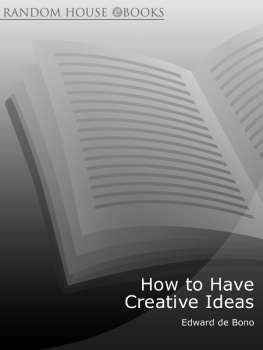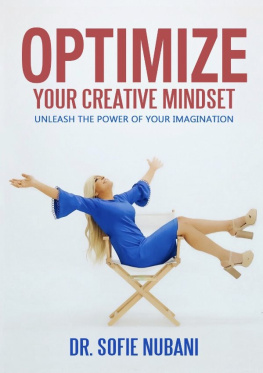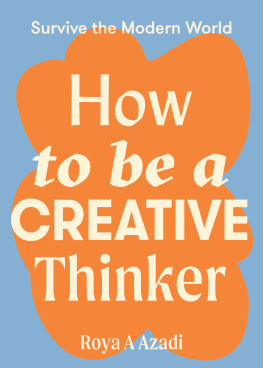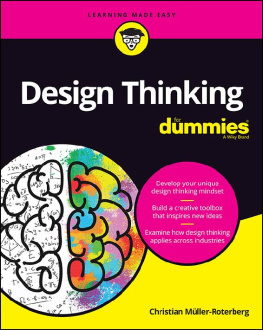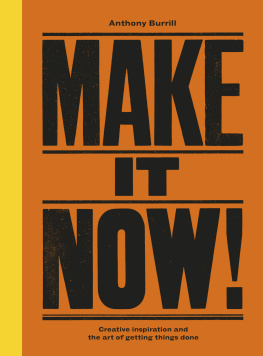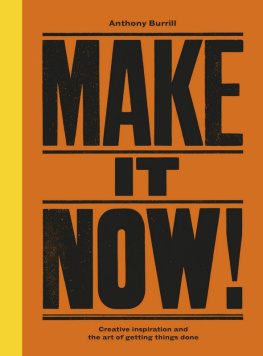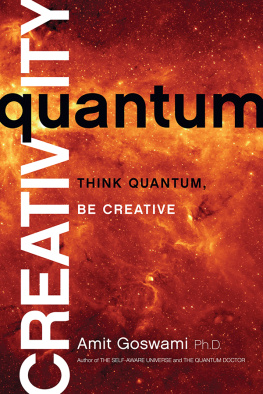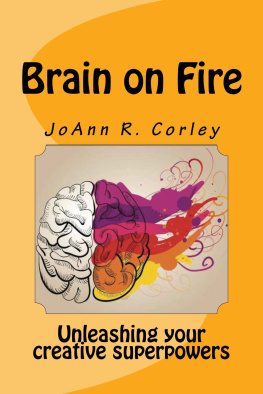
THE POWER OF
THINKING
DIFFERENTLY
An Imaginative Guide to
Creativity, Change, & the Discovery of New Ideas
JAVY W. GALINDO
Hyena Press
Los Altos, CA
Copyright 2010 by Javier W. Galindo
www.thinking-differently.com
All rights reserved. No part of this book may be reproduced or transmitted in any form or by any means, electronic or mechanical, including photocopying, recording, or by an information storage and retrieval system
except by a reviewer who may quote brief passages in a review to be printed in a magazine, newspaper, or on the Webwithout permission in writing from the copyright owner.
This book is published by Hyena Press
2310 Homestead Rd, C1 #125
Los Altos, CA 94024
www.HyenaPress.com
Also available in hardcover and paperback.
Although the author and publisher have made every effort to ensure the accuracy and completeness of information contained in this book, we assume no responsibility for errors, inaccuracies, omissions, or any inconsistency herein. Any slights on people, places, or organizations are unintentional.
First Ebook Edition
ISBN 978-0-9842239-0-9
Library of Congress Control Number: 2009938841
Cover art: Christine Nolasco
Book design: Susan Reed
Print Book Design: Susan Reed
Ebook Design: Salah Al-Din Talhami
Editor: Liza Joseph
ATTENTION CORPORATIONS, UNIVERSITIES, COLLEGES, PROFFESIONAL ORGANIZATIONSDISCOUNT ON BULK PURCHASES AVAILABLE.
For information, please contact the publisher:
www.HyenaPress.com, info@hyenapress.com, (408) 329-4597
This book is dedicated to all those who have inspired me:
To all of my friends who have dared to try something new and who have shown the courage to be different.
To the child I once was and every adult I see who plays with ideas in a childlike spirit.
For more information:
www.Thinking-Differently.com
For free articles and interviews:
www.PicklesAndDoughnuts.com
Contents
Preface
An Introduction: Now for Something Completely Different
PART I - What: Surveying The Creative Landscape
CHAPTER ONE: Looking Beyond Our Island
CHAPTER TWO : Constellating the Creative Process
PART II - How: The Creative Journey
The 1st Aspect: The Ordinary World
CHAPTER 3: Origins of Our Ordinary World: The Science of Visual Perception
CHAPTER 4 : Origins of Our Ordinary World (The Sequel): The Science of Common Sense Thinking
CHAPTER 5 : The Stage of Innocence
The 2nd Aspect: Answering the Call to Think Differently
CHAPTER 6: Crossing the Threshold: Should I Stay or Should I Go?
CHAPTER 7: The Stage of Becoming an Orphan
The 3rd Aspect: Entering the Sea of Possibilities
CHAPTER 8: Examining the Origins of Our Dominant Ideas and Behaviors
CHAPTER 9: Scientific Evidence for the Possibility of Thinking Differently
The 4th Aspect: Trials and Tribulations of Finding New Ideas
CHAPTER 11: The Not-So-Secret Secrets to Out-of-the-Box Thinking
CHAPTER 12: Exercising Our Creative Muscles
CHAPTER 13: The Stage of Wandering
The 5th Aspect: Retrieving the Reward
CHAPTER 14: How to Attract Flashes of Insight
CHAPTER 15: The Stage of the Warrior
The 6th Aspect: The Return Home
CHAPTER 16: Integrating the Two Worlds: Manifesting Ideas into a Reality
CHAPTER 17: Thinking Differently as a Creative Journey
CHAPTER 18: Trapped in the Abyss
CHAPTER 19: Answering the Call to Think Differently
CHAPTER 20: Life, Liberty, and the Pursuit of Meaning
Book Notes
Bibliography
Acknowledgments
About the Author
Preface
After a rough, six-mile morning run on the Rancho San Antonio County Park hills, I drove over to a local caf and marched in with sweat still dripping off my forehead.
The night before, I had planned to spend the day cranking out an outline for a research document on creative thinking, the creative process, and creative insight. However, after I drew out my laptop and a stack of research notes from my chic carrying case, I realized there was one glaring problemI didnt have an urge to do it.
Also, I had no idea how Id hammer it all into something that made sense. So I guess thats two problems.
Over a year, I had researched, looking at the creative process in business, art, technology, and science. I studied scores of creative writers, inventors, and many more. I looked into psychology, neuroscience, and numerous popular books on creative thinking, lateral thinking, out-of-the-box thinking. But, here in the caf, I saw no way to organize this information.
Instead, I was overwhelmed by the desire to play around at the bookstore nearby. So I did just that.
At the bookstore, I was drawn to some books on story, myth, and tales of heroic adventure. For a good half an hour, I was among these books, with their fancy titles and enticing covers.
Then suddenly, inspiration struck.
Can it all really fit like that?
Ideas flowed unimpeded into my head. I struggled to keep track of them all. Standing in a corner, I jotted it all down in the only thing I had on memy cell phone. My thumbs flailed away at the tiny keys, and in about an hour, I had finished the first draft of an entire outline of my research document.
Thats crazy! I told myself. Where did these creative ideas come from? Why did these ideas rush in when I was most unprepared?
Can I set myself up to experience such creativity again?
I then laughed out loud. These were exactly the same questions I had been spending all my time researching.
These are also the same questions that I address throughout this book.
I began my research with the goal of widening my understanding of the creative process. I wanted to learn to speak of the creative process in various contexts in order to be able to relate to a broader spectrum of people. More so, like a novice astronomer making sense of the night sky, I wanted to constellate a more complete picture of the whats, hows and whys of creativity, and this included the often-overlooked neuroscientific perspective.
Through this investigation, I have come to realize that creative insight is not only a valid approach to accessing new information, but that it is an evolutionary gift that enables us to change, learn, and adapt to a complex, ever-changing world. Our creative facultiesand the aha flashes of insight that often come from themseem much less pseudo-science than I had once thought. Nor do they seem to be mere extraneous by-products of a rational mind. On the contrary, our ability to consciously and subconsciously make new connections seems to be a necessary complement to a thought process based on snap judgments that inherently reinforce our dominant perceptions and ideas.
Our creative faculties are our brains most advanced tools for perceiving, thinking, problem solving, and generating new ideas. They are the keys to resourcefulness, discovery, enlightenment, innovation, inventiveness, and ingenuity. You may be comfortable with the old horse and buggy, but what about the latest sports car in your driveway?
Lets take it out for a spin. You may just be surprised by what it can do.
An Introduction:
Now for Something Completely Different

Do you remember how creative you were as a child?
The world was still new and we were experts at using our imaginations to fill in the blanks of our knowledge. We played make-believe, pretend, and we laughed at the most ridiculous things. Maybe, you had fun with dolls, toy soldiers, and rocks in the backyard, or played treasure hunt with your neighbors.
Next page


